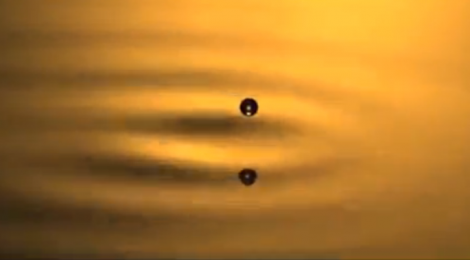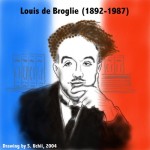
Quantum Physics Isn’t So Spooky, Pilot Waves Make It Happen
Quantum physics has been treated for decades as a field full of mystery and spooky actions but it simply isn’t. It’s no longer probabilistic it is simply blazingly fast at being deterministic.
Our reigning laws of quantum physics seem to suggest that particles spend much of their time in a ghostly state lacking such simple properties as having a definite location and instead existing everywhere and nowhere at once. Recall Schrodinger’s cat which exists in its box as both alive and dead. Only when we poke the cat does it suddenly materialize, appearing to us as being either alive or dead as if by a roll of the dice.

My paired stainless steel test tubes used to demonstrate cold fusion production of helium in gas phase D2/Pd nanoparticle experiment with real time QMS for helium. Naturally one test tube was a control cell which faithfully showed no helium.
Or in my field of fancy Cold Fusion we face a similar mystery. How do my deuterons trapped in palladium lattice boxes know whether to be either singlet deuterons or doublet deuterons that become a 4He nuclei. Read about my finding of 4He in this Wired Magazine article.
Conventional physicists are prone to recite chapter and verse of their book of rules that say the probability of the 4He configuration coming into existence from deuterium in a benignly room temperature state is so impossibly small it will never be seen in the lifetime of the universe. Indeed the probability is for just 1 DD → 4He fusion occurrence every 10 trillion years.
They argue from their armchair pulpits that therefore the prima facie evidence of probabilities, even proof, is that my, and others, observation of 4He is bumbling experimental error or worse. Especially since we definitively measure a trillion 4He being produced every second!
However in the light of a deterministic quantum universe there is guidance that helps improbable things happen whenever there is an energetic advantage to do so. It’s such a pleasure to now find a growing legion of physicists endorsing a deterministic universe and the myriad wonders of nature it facilitates and explains.
In my work I have but to coax my deuterons into confinement in my solid state lattice box. Once there they no longer require the difficult and improbable feat that is like herding cats through an ever moving Coulomb barrier. With deterministic help they behave like beautiful purring kittens.
In the box, without a paws, those quarky deuteron kitties instantly test every possible pathway to become the more energetically perfect 4He nucleus. They are collectively guided in this by the accumulation of quantum pilot waves which test and identify the proper path to follow in a blazingly fast quantum moment of time.
Once one kitten (or fuzzy bag of quarks as I like to think of them) spots that waving guiding quantum string it goes for it. But not alone, for what one kitten sees its litter-mates see the same thing at or nearly at the same instant. As they pounce any two of the little quark bundles of joy might reach a helium state of nirvana, 4He. Their excess energy is distributed within the box as simple heat instead of concentrated nucleon binding energy. Now if that is not a LOL Cat moment I don’t know what is.
But lets back up for a moment and look at the reigning and wrong view of the probabilistic universe.
The reigning “Copenhagen Interpretation” of quantum physics is named after the Danish home of physicist warlord Niels Bohr. By dictum it proscribes that particles live in an isolated, dogmatic existence and individually constantly play out all possible realities. Any particular observed result is determined by simple probability and chance something that is more easily mathematically described.
This probable dogma of quantum mechanics says nothing a priori about a particle’s properties. Their properties come only into being in the instant of observation and measurement. But this simplified probability math is simply said to work and if you want an explanation why – tough.
Seth Lloyd, a quantum physicist at MIT, noted, “Quantum mechanics is just counter-intuitive and we just have to suck it up.”
Some physicists now disagree. “Quantum mechanics is very successful, nobody’s claiming that it’s wrong,” said Paul Milewski, (University of Bath). He has has written computer models of new deterministic quantum dynamics. “What we believe is that there may be, in fact, some more fundamental reason why [quantum mechanics] looks the way it does.”
Does Nature Like To Ride The Waves
 The idea that quantum pilot waves might influence how particles behave and interact dates back to the early days of quantum mechanics. Louis de Broglie was the first to describe wave-particle duality in 1926. He then presented the earliest version of pilot-wave theory at the 1927 Solvay Conference in Brussels, perhaps the most famous gathering of the founders of the field of quantum physics.
The idea that quantum pilot waves might influence how particles behave and interact dates back to the early days of quantum mechanics. Louis de Broglie was the first to describe wave-particle duality in 1926. He then presented the earliest version of pilot-wave theory at the 1927 Solvay Conference in Brussels, perhaps the most famous gathering of the founders of the field of quantum physics.
The quantum phenomenon of particle wave duality has since been very difficult to understand because no-one has ever observed something being both a particle and a wave in the everyday world. It may be that the direct observation of this duality is impossible but the observation of the consequences of quantum behaviour is more easily done.
Dr. de Broglie professed to colleagues Bohr, Albert Einstein, Erwin Schrödinger, Werner Heisenberg and two dozen other celebrated physicists, that pilot-wave theory made all the same predictions as the probabilistic formulation of quantum mechanics but without the need for spooky or mysterious requirements.
His nemesis Bohr, maintained that his single equation represents likely and unlikely locations of particles as peaks and troughs of a wave. Bohr claimed and defended his probability-wave equation as a perfect definition of the virtual particle.
But de Broglie championed and argued for the use of two equations. One describing a real, physical wave, and another tying the path of an actual, concrete particle to the influences in that wave equation. De Broglie’s particle is like a surfer riding and guided by the wave rather than being like a grain of sand tumbled along within it, indistinguishable from the wave until fixating upon it.
During the the Solvay conference, Einstein fought against Bohr’s notion of a probabilistic universe, proclaiming “God does not play dice.” But Al stopped short of embracing and defending de Broglie’s ideas. Bohr who was one of the few who could stand up to Einstein challenged his sound bite with his own admonishing him to “stop telling God what to do,” and in the end his probabilistic notion and sound bite reigned as the flavour of the day.
A few years later (1932) John von Neumann published his “proof” that the probabilistic wave equation in quantum mechanics could have no “hidden variables”, especially those of de Broglie’s particle with its deterministic trajectory. De Broglie’s wave theory was condemned to the dust bin of physics for decades even though von Neumann’s proof was relatively quickly disproved.
The deterministic view of quantum physics today is not even mentioned in most textbooks resulting in the fact that very few people in the field have ever heard of it. Sheldon Goldstein, a professor of mathematics, physics and philosophy at Rutgers University and a fan of pilot-wave theory, blames the “preposterous” neglect of the theory on “decades of indoctrination.” In this day and age, Goldstein and several others noted, researchers risk their careers by questioning probabilisitic quantum orthodoxy.
How does this new deterministic view come about
In a groundbreaking macroscopic experiment, the Paris researchers, Yves Couder and colleagues at Paris Diderot University, used a quantum drop experiment to demonstrate single and double-slit interference. Such macroscopic drop experiments show a drop of silicon oil can be made and seen to bounce indefinitely on a vibrating pool of oil. It’s path has long been said to be random but upon closer study is shown to be deterministic.
The video below by MIT scientists Harris and Bush shows how a bouncing drop of oil takes on deterministic behaviour.
They discovered that when a droplet bounces toward a pair of openings in a dam-like barrier, it passes through only one slit or the other, while the pilot wave passes through both. Repeated trials show that the overlapping wave-fronts of the pilot wave steer the droplets to certain places and never to locations in between — an apparent replication of the interference pattern in the quantum double-slit experiment that Feynman described as “impossible … to explain in any classical way.”
Quantum droplets also appear to “tunnel” through barriers, orbit and bind with each other in stable “bound states,” and exhibit properties analogous to quantum spin and electromagnetic attraction. When confined to circular areas called corrals, they become entangled in concentric rings analogous to the standing waves generated by electrons in quantum corrals.
In these droplet tests, the droplet follows a chaotic path that reveals the statistical distribution in the macroscopic fluid system is the same as expected of particles at the quantum scale. But rather than resulting from spooky or mysterious uncertainty these quantum-like effects are driven by “path memory.” Every bounce of the droplet leaves ripples, and these ripples deterministically influence the droplet’s future bounces and lead to quantum-like statistical outcomes.
The more path memory develops the more precise and quantum-like the statistics become. “Memory generates chaos, which we need to get the right probabilities,” Couder explained. “We see path memory clearly in our system. It doesn’t necessarily mean it exists in quantum objects, it just suggests it would be possible.”
For me this concept neatly helps dismiss the need for miracles in two fields of interest photosynthesis and cold fusion.

E. ciliata are shown to make selective use of quantum optimized pathways making for vastly enhanced photosynthesis
The quantum phenomenon has since been very difficult to understand because no-one has ever observed something being simultaneously both a particle and a wave in the everyday world.
It may be that the direct observation of this duality is impossible but the observation of the consequences of quantum behaviour is more easily done.
Take for example the observations of photosynthetic processes being seen to be dramatically enhanced by what may well be “pilot waves.” Some photosynthetic systems are seen to display quantum properties even at ambient temperatures.
A team at UC London have worked to identify features in these biological systems which can only be predicted by quantum physics, and for which no classical analogues exist.
“Energy transfer in light-harvesting macro-molecules is assisted by specific vibrational motions of the chromophores,” said Alexandra Olaya-Castro (UCL Physics & Astronomy), supervisor and co-author of the research. “We found that the properties of some of the chromophore vibrations that assist energy transfer during photosynthesis can never be described with classical laws, and moreover, this non-classical behaviour enhances the efficiency of the energy transfer.” Their paper in Nature Jan. 2014 describes the work.

Palladium target foil melted while immersed in a room temperature heavy water (D2O) cold fusion experiment subjected to 1 w/cm2 ultrasound. Examination of metal showed it to be saturated with 4He in profoundly anomolous 3He:4He ratios.
Cold fusion has always been criticized for its lack of obedience to the dogma of physics. How for example could two deuterons possibly overcome the statistically calculable impossibly improbability of crossing the Coulomb Barrier.
Cold fusion effects of producing heat and helium can be seen in apparent abundance in many of my experiments. Surely our critics have howled our experimental observations of heat and helium must be dis-proven and dis-credited by their armchair probabilistic mathematics.
Thanks to the re-emerging field of Pilot-Wave Physics the path for cold fusion as a highly probable deterministic event is clearly in hand. We live in a quantum universe where nature has always found a way through deterministic quantum effects to provide the means for cold fusion to not only curiously exist. It must exist.
Herding the kittens into the box is not so difficult. Once inside we just have to let nature takes it course.
For a truly incredible description of this topic go to Quanta Magazine June 2014 – Fluid Test Hint At Concrete Quantum Reality
Quanta has an another account A New Physics Theory Of Life that dovetails nicely with the above article.